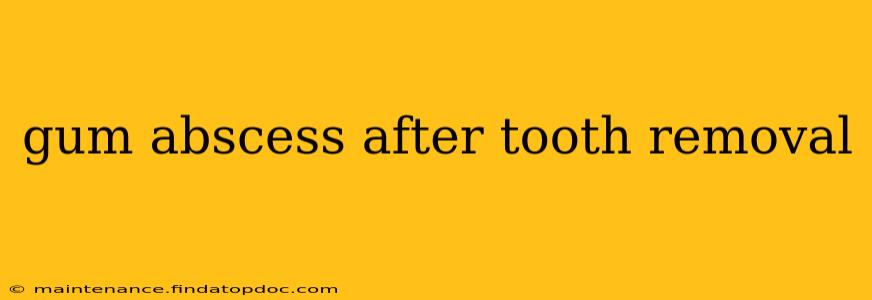A gum abscess after tooth removal, also known as a post-extraction alveolitis, is a painful complication that can occur after a tooth is pulled. While not common, it's crucial to understand its causes, symptoms, and treatment options to ensure prompt resolution and prevent further complications. This comprehensive guide will address common concerns and provide valuable information for anyone experiencing this issue.
What Causes a Gum Abscess After Tooth Removal?
A gum abscess develops when bacteria infect the gum tissue surrounding the extraction site. Several factors can contribute to this infection:
-
Dry Socket: This is the most common cause. A dry socket occurs when the blood clot that normally forms in the extraction site dislodges or fails to form properly. This exposes the underlying bone and nerve endings, making the area extremely susceptible to infection. Smoking, vigorous rinsing, and using a straw after extraction increase the risk of dry socket.
-
Residual Infection: If the tooth was infected before extraction, remaining bacteria can lead to an abscess in the surrounding gum tissue.
-
Poor Oral Hygiene: Inadequate brushing and flossing can allow bacteria to proliferate, increasing the risk of infection after extraction.
-
Traumatic Extraction: A complicated extraction that damages the surrounding tissues can create an environment conducive to infection.
-
Foreign Body: Sometimes, small pieces of the tooth or other debris can remain in the extraction socket, acting as a nidus for infection.
What are the Symptoms of a Gum Abscess After Tooth Removal?
Recognizing the symptoms of a gum abscess is crucial for seeking timely treatment. These symptoms may include:
- Severe Pain: This is often the most prominent symptom, often radiating to other parts of the face.
- Swelling: The gum tissue around the extraction site may become noticeably swollen.
- Redness and Inflammation: The gums may appear red, inflamed, and tender to the touch.
- Bad Breath: A foul odor emanating from the mouth is common due to the infection.
- Pus: A yellowish or whitish pus may be visible in or around the extraction site.
- Fever and Chills: In some cases, a systemic infection may develop, resulting in fever and chills.
How is a Gum Abscess After Tooth Removal Treated?
Treatment focuses on eliminating the infection and promoting healing. Your dentist will likely perform the following:
- Irrigation and Debridement: The extraction site will be thoroughly cleaned to remove any debris, necrotic tissue, or foreign bodies. This usually involves rinsing with saline or an antiseptic solution.
- Medications: Antibiotics are frequently prescribed to combat the infection. Pain relievers, such as ibuprofen or acetaminophen, can help manage pain and inflammation. In some cases, stronger pain medications may be necessary.
- Packing the Socket: The dentist may pack the socket with medicated gauze or other materials to help promote healing and protect the exposed bone. This is common in dry socket cases.
- Follow-up Appointments: Regular follow-up appointments are crucial to monitor the healing process and ensure the infection is resolved.
How Long Does it Take for a Gum Abscess to Heal After Tooth Removal?
Healing time varies depending on the severity of the infection and individual factors. It typically takes several days to a few weeks for the infection to clear up. However, complete healing of the extraction socket might take several months.
Can a Gum Abscess After Tooth Removal Spread?
Yes, if left untreated, a gum abscess can spread to adjacent tissues, potentially leading to more serious complications such as cellulitis (a spreading bacterial infection of the skin and subcutaneous tissues) or even a potentially life-threatening condition called Ludwig's angina (a severe infection of the floor of the mouth).
How Can I Prevent a Gum Abscess After Tooth Removal?
Taking preventative measures can significantly reduce your risk of developing a gum abscess after a tooth extraction. These measures include:
- Following your dentist's post-operative instructions carefully: This is paramount.
- Maintaining good oral hygiene: Gently brush and floss your teeth, avoiding the extraction site immediately after the procedure.
- Avoiding smoking and alcohol: These substances can hinder healing and increase infection risk.
- Avoiding strenuous activity: This can disrupt the blood clot formation.
- Eating a soft diet: This reduces the risk of dislodging the blood clot.
- Using prescribed medications as directed: This helps to control pain and fight infection.
What should I do if I suspect a gum abscess after a tooth extraction?
Contact your dentist or oral surgeon immediately if you experience any signs or symptoms of a gum abscess following tooth removal. Early intervention is crucial for effective treatment and preventing complications. Don't hesitate to seek professional help if you have concerns. Early diagnosis and treatment significantly improve the chances of a speedy recovery.
